
The flagtails are a family (Kuhliidae) of perciform fish of the Indo-Pacific area. The family consists of several species in one genus, Kuhlia. Most are euryhaline and often found in brackish water, but the genus also includes species restricted to marine or fresh water.
The spikey bass is a species of ray-finned fish in the family Latidae, the lates perches. It is endemic to coastal waters off Western Australia, where it inhabits areas with soft substrates. It is the only species in the monotypic genus Hypopterus.
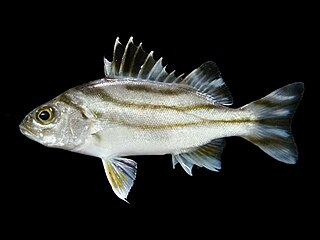
Grunters or tigerperches are ray-finned fishes in the family Terapontidae. This family is part of the superfamily Percoidea of the order Perciformes.

Aplodactylus is a genus of marine ray-finned fishes, commonly known as marblefishes or sea carps. It is the only genus in the monogeneric family, Aplodactylidae. The fishes in this genus are found in the south eastern Indian Ocean and the southern Pacific Ocean.
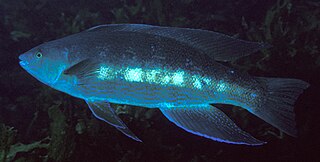
The Odacidae are a small family of ray-finned fishes formerly classified within the order Perciformes, commonly known as cales, and weed whitings. They are related to the much larger families of the wrasses and parrotfish. More recent workers have classified this family within the order Labriformes, alongside the wrasses and parrotfishes, within the clade Percomorpha.
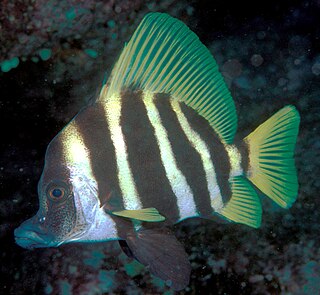
The striped boarfish, also known as whiskered boarfish, Japanese boarfish, sailfin armourhead or whiskered armorhead, is a species of marine ray-finned fish, an armourhead om the family Pentacerotidae, which is native to the Pacific Ocean from the Hawaiian Islands westward to the coast of Asia and Australia. This is a reef-dwelling fish found at depths between 18 and 193 m. It can reach a total length of 90 cm (35 in). It is currently the only known member of the genus Evistias.

Dermatolepis is a genus of marine ray-finned fish, groupers from the subfamily Epinephelinae, part of the family Serranidae, which also includes the anthias and sea basses. They are found in the western Atlantic, Pacific and Indian Oceans.

Gymnocephalus is a genus of ray-finned fishes from the family Percidae, which includes the perches, pike-perches and darters. They are from the Western Palearctic area, although one species, Gymnocephalus cernua has been accidentally introduced to the Great Lakes region where it is regarded as an invasive species. They have the common name "ruffe" and resemble the true perches in the genus Perca, but are usually smaller and have a different pattern.

The false trevally is a species of fish in the family Lactariidae, currently the sole member of the family.

Hapalogenys, the barbeled grunters or velveltchins, is a genus of marine ray-finned fish, it is the only genus in the monotypic family Hapalogenyidae, also spelled Hapalogeniidae. The species of this genus are found in depths between 30 and 230 m in coastal areas and river mouths from the shores of southern Japan to the Bay of Bengal and Northwestern Australia.

Parabembras is a genus of marine ray-finned fish belonging to the family Bembridae, the deepwater flatheads, although they are sufficiently different from the other genera in that family to be classified as their own family, Parabembradidae, by some authorities. These fishes are found in the Indian Ocean and the western Pacific Ocean.

Pseudocaranx is a genus of ray-finned fishes from the family Carangidae, the jacks, trevallies, scads, and pompanos. They occur in the western Atlantic Ocean and the Indo-Pacific.

The stripey, also known as the footballer or convict fish, is a species of ray-finned fish, a sea chub from the subfamily Microcanthinae which is part of the family Kyphosidae. It is native to the Pacific Ocean where it has a wide range. This species may be found in the aquarium trade. It is the only known member of its genus.
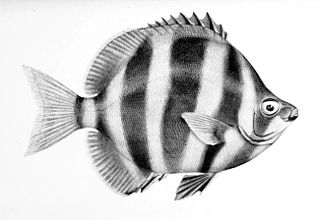
The moonlighter, is a species of marine ray-finned fish, a member of the subfamily Microcanthinae, part of the sea chub family Kyphosidae. It is endemic to southern Australia, where adults can be found on rocky reefs to depths of 120 m (390 ft). Juveniles are found in much shallower waters of coves and estuaries. This species grows to 40 cm (16 in) TL. This fish is commercially important and can also be found in the aquarium trade. This species is the only known member of the genus Tilodon.

Polynemus is a genus of threadfins. They are native to South and Southeast Asia and, depending on the species, occur in freshwater, brackish, and/or marine environments.
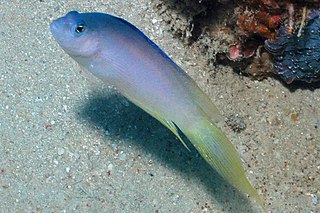
The sailfin dottyback, also known as the longtail dottyback, is a species of ray-finned fish from the family Pseudochromidae, the dottybacks from the Western Central Pacific where it is found on the Great Barrier Reef and other coral reefs in the Coral Sea, where it is occurs inshore near rock and coral formations where there are sandy bottoms. This fish occasionally makes its way into the aquarium trade. It grows to a size of 12 centimetres (4.7 in) in length. It is pale greyish to yellowish in colour and has bluish upperparts, a bluish dorsal fin which fades to yellow posteriorly and it has a dark blue spot at the anterior end of the dorsal fin.

Polyprion is a genus of marine ray-finned fish from the family Polyprionidae, the wreckfishes.

The threadtail anthias is a species of marine ray-finned fish, an anthias from the subfamily Anthiinae part of the family Serranidae, the groupers and sea basses. It is the only member of the genus Tosana. It is found in the Western Pacific Ocean from Japan to the South China Sea in deep coastal waters over sandy-muddy substrates.
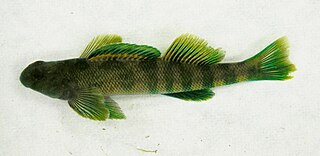
Etheosomatidae is a species-rich subfamily of freshwater ray-finned fish, the members of which are commonly known as the darters. The subfamily is part of the family Percidae which also includes the perches, ruffes and pikeperches. The family is endemic to North America. It consists of 3-5 different genera and well over 200 species.

Lopholatilus villarii, the tilefish, is a species of marine ray-finned fish, a tilefish belonging to the family Malacanthidae. It is native to the western South Atlantic Ocean off the coasts of Brazil, Uruguay and Argentina. This species was first formally described in 1915 by the Brazilian naturalist Alpilio de Miranda Ribeiro (1874-1939) with the type locality given as Praca do Mercado, Brazil. The specific name honours the Brazilian naval captain Frederico Otávio de Lemos Villar (1875-1964) who participated in fisheries research off Brazil.



















